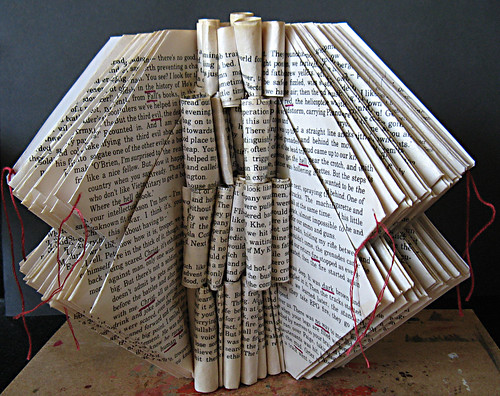
Book Art By Liz Hamman
Binding, Bookmaking and Book Forms: One of the most intriguing and tell-tale signs of a work of book art is an interrogation of the book's form, structure, and content, including the investigation of historic and new forms of books. This investigation can begin or end at any point in the bookmaking process: selection of materials, paper structures (including accordions and other folded structures), printing (letterpress, hand press, inking, painting, lithography, and so on.), or binding.

[Reconstructed Book by UK textile artistJackie Bowcutt]
Sculptural Books: Sculptural books are works of art that begin or end with the book form. In the former, books are often manipulated by dis-assembly and re-assembly to create new structures. The popular terms "hacked books" or "altered books" can also sometimes be used to describe the resulting structures, although these terms are generally applied to more crafted objects. For the latter, various materials are reinterpreted to form book-like structures.
Construction, Re-Construction and Deconstruction: Many artists explore the medium of the book through a process of construction, deconstruction, or re-construction. Construction concerns the basic elements of the book: spine, cover, signatures (groups of bound pages). Deconstruction explores the disassembling of the book form either at the physical or figurative level. Re-construction explores not only the disassembling of the book into its basic elements but also the creation of the book, at times using alternative or re-used materials. Materials as diverse as cloth, steel, and plastic have been adapted into the book form as well as objects such as jars, boxes (including wunderkammer pieces), and other forms exploring the book as "container" or catalog. Re-construction can also involve taking apart or modifying existing books as well as other printed materials (magazines, comics, etc.) to create new forms (see book-like objects).
Self-Reflexivity: Some works of book art, particularly artist's books, demonstrate in either their material make up, contents, or both an awareness of their own "bookish" qualities. This self-referential acknowledgment may call to mind questions about the role of artist's books (or books and art independently) in society.
Editions and Multiples: Works of Book Art can appear as limited edition, one of a kind pieces, or multiples (intended for mass production & distribution). The level of production of the book may indicate the book's intended distribution, target, or agenda.
[Stainless steel object "The Book" by Czech artist JAROSLAV VÁLEK]
Book-like Objects: A sub-category of sculptural books. These works typically resemble or manipulate facets of the book but are not necessarily considered in and of themselves books (i.e. meant to be "read"). Works of this sort typically challenge the role of books as inherently useful objects, in contrast to fine art's famed in-utility.
Fine Press & Fine Binding: Fine press refers to materials printed in a highly decorative manner, such as with letterpress or elements of the hand such as illuminated lettering, glorifying the text. These works often follow in the tradition of William Morris. Fine press works are not necessarily considered "artist's books" as they do not necessarily interrogate the structure of the book in a critical manner. Similarly, fine binding is decorative or luxurious binding that glorifies or re-interprets the contents of the book. Fine binding alone does not, for the same reason, necessarily qualify a book as an artist's book.
Zines: Zines are normally low-budget, homemade or small press magazines which may include either text and / or images as well as other content (there are zines, for example, that take an audio format). No one seems to agree where zines fit in the world of Book Art, or if they even fit in at all. Many book artists tend to cringe at the word “zine" and with some justification. Zines do not necessarily challenge the book form. To aggravate the problem further, to many who are unfamiliar with the field of book arts, self-publication or zine making appear to be in equivocal standing with book art. One could see how the trained book artist might take offense to this. At the same time, many well respected limited edition publications started as zines and many democratic multiples could still be considered “zines.”

[A selection of zines. Photo from We Make Zines]
Of course this is just a very brief overview of some concepts central to book art, a field as diverse as book artists are themselves. In lieu of creating an exact definition for the term, which may in the end prove as difficult as defining art itself, this blog hopes to create a comprehensive overview, acting as a survey of the history of book art up to the present, a platform to debate current topics and trends in the field of book art, an introduction to currently active book artists worldwide, and a digital platform for the highly physical world of book art.
Good luck again with this venture. I will link to you in my next post.
ReplyDeletejust found and bookmarked your blog.
ReplyDeletelook forward to finding great inspiration in future.
scrapbook-crazy.com